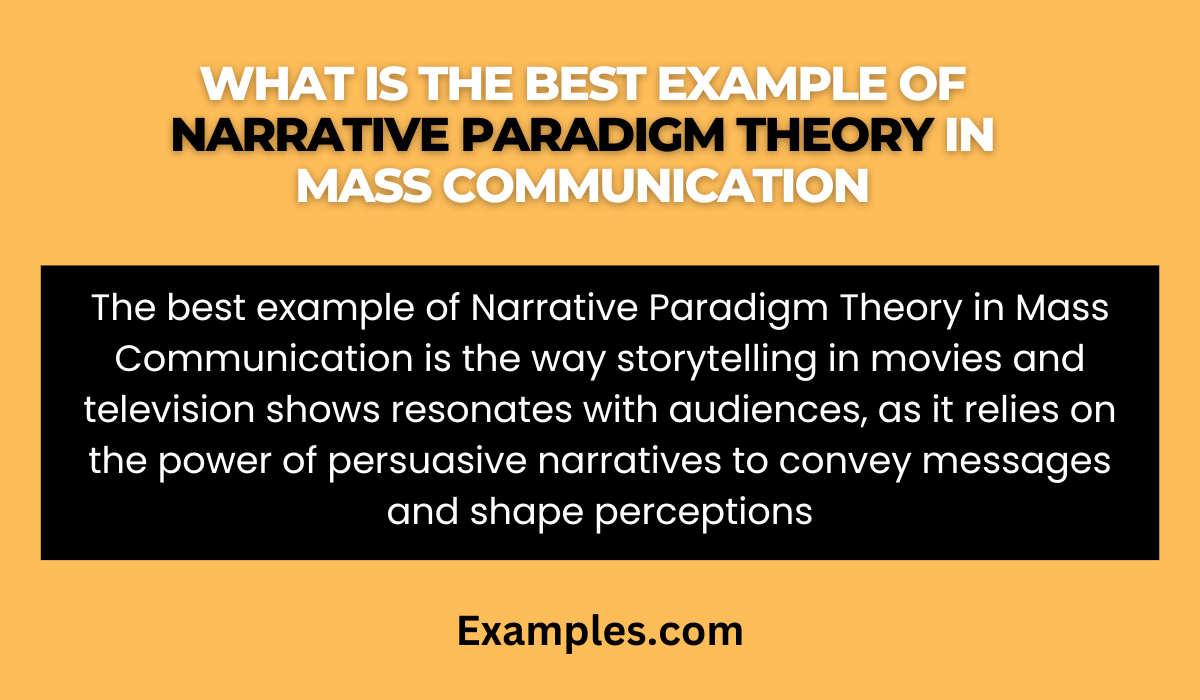29+ Narrative Paradigm Theory in Mass Communication Examples
Narrative Paradigm Theory revolutionizes our understanding of Mass Communication. It unfolds the power of storytelling in conveying complex messages in a relatable, impactful manner. This guide delves into how narratives shape public perception and influence societal norms. It’s a vital tool for anyone in the realm of mass media, from public relations to journalism. Through real-life examples, we demonstrate how this theory plays a crucial role in effective communication.
What is Narrative Paradigm Theory in Mass Communication?
Narrative Paradigm Theory in Mass Communication is an innovative approach that emphasizes the role of storytelling in shaping our understanding of the world. It posits that humans are natural storytellers, and we comprehend life events as a series of narratives. This theory suggests that effective communication, especially in Mass Communication, relies more on the coherence and emotional impact of these stories rather than just logical arguments. It’s pivotal in fields like journalism, broadcasting, and digital media.

History of Narrative Paradigm Theory in Mass Communication
Narrative Paradigm Theory is a significant concept in mass communication, developed by Walter Fisher in the 1980s. Fisher proposed that all meaningful communication is a form of storytelling or narration, where people make sense of the world through a narrative lens. This theory challenged the traditional models of communication which were primarily based on argumentative and logical reasoning.
What is the Best Example of Narrative Paradigm Theory in Mass Communication?
A prime example of Narrative Paradigm Theory in Mass Communication is its application in social media campaigns. These campaigns often utilize compelling stories to connect with audiences on an emotional level, leading to greater engagement and impact. Another notable example is in television broadcasting, where narrative storytelling is used to present news and events in a manner that resonates with viewers, making complex issues more understandable and relatable. These examples highlight how narrative structures are integral to effective communication in various mass media platforms.

30 Examples of Narrative Paradigm Theory in Mass Communication
Narrative Paradigm Theory, integral in mass communication, emphasizes the role of storytelling in shaping human understanding. It’s pivotal in various mass communication scenarios, as it guides how messages are crafted and received. This approach transcends traditional mass communication characteristics, underscoring the power of narrative in influencing societal beliefs and behaviors.

- Television News Segments: Reporters use narrative structures to make news relatable and memorable.
- Public Service Announcements: Stories are used to emotionally engage and inform the public about important issues.
- Social Media Campaigns: Brands narrate stories to connect with audiences on a personal level.
- Documentaries: They often use narrative storytelling to present factual information engagingly.
- Radio Broadcasting: Radio hosts use storytelling to engage listeners and convey messages effectively.
- Corporate Communication: Businesses use narrative strategies in annual reports to share their progress.
- Political Speeches: Politicians often use narratives to resonate with their audience’s experiences.
- Advertising Campaigns: Ads frequently tell a short story to create an emotional connection with the product.
- Journalistic Reporting: Journalists use narrative elements to make complex issues accessible and engaging.

- Film and Television Scripts: These often follow narrative structures to communicate themes and messages.
- Public Relations Campaigns: PR strategies often involve storytelling to shape public perception.
- Educational Broadcasting: Narrative techniques are used to make learning content more engaging.
- Podcasting: Hosts often use personal stories to connect with listeners and enhance the message.
- Marketing Emails: Companies use narrative in emails to build a relationship with consumers.
- Billboards: Even in brief, billboards can tell a story or part of a narrative to capture attention.
- Print Journalism: Feature articles often use narrative to detail events or profiles.
- Social Media Influencing: Influencers share stories to create relatable content for their followers.
- Photography in Journalism: Photojournalists tell stories through visuals, complementing written narratives.
- Blogging: Bloggers use personal or themed narratives to engage and inform readers.
- Crisis Communication: Effective crisis management often involves narrative framing to control the message.
- Radio Advertisements: Ads on the radio use storytelling to make products or services memorable.
- Music Videos: These often tell a story to deepen the song’s impact.
- News Websites: Online news incorporates narrative elements for a more immersive reading experience.
- Digital Marketing: Digital platforms use narrative to create impactful advertising.
- Cinema Trailers: Trailers use a condensed narrative to attract potential viewers.
- Community Radio: Local stories are shared to engage and inform community members.
- Press Releases: Companies use narratives in releases to make announcements more engaging.

- Educational Videos: Narrative elements are included to make educational material more appealing.
- Health Communication Campaigns: Narratives are used to make health messages more persuasive.
- Cultural Reporting: Reporters use narrative to share cultural events and stories with a broader audience.
Role of Narrative Paradigm Theory in Mass Communication
- Humanizing Communication: The theory emphasizes that storytelling is a natural human skill and communication is often more persuasive when presented in a narrative form.
- Broadening Understanding: It allows a broader understanding of communication, considering not just facts and data but also incorporating the emotional and cultural dimensions.
- Enhancing Engagement: Narratives in mass communication are instrumental in engaging audiences more effectively than mere presentation of facts.
- Cultural Resonance: The theory acknowledges the role of culture, values, and experiences in shaping narratives, making them resonate more with diverse audiences.
- Ethical Consideration: It places importance on the moral and ethical aspects of communication, encouraging responsible storytelling.
- Versatility Across Media: The narrative paradigm is adaptable across different forms of mass communication – from Television Mass Communication to Social media Mass Communication.
- Influencing Public Opinion: Narratives shape public opinion by providing a more relatable and comprehensible perspective on complex issues.
- Educational Utility: In educational contexts like Mass Communication Examples in School, narratives aid in more effective learning and retention.
- Commercial Application: In Mass Communication in Advertising, narratives create more impactful marketing messages.
- Political and Social Impact: The theory is significant in understanding the role of media narratives in shaping political and social discourses.
Importance of Narrative Paradigm Theory in Mass Communication
Narrative Paradigm Theory is a pivotal concept in the realm of Mass Communication. This theory, developed by Walter Fisher, posits that all meaningful communication is a form of storytelling or narration. In today’s media-saturated environment, understanding this theory is crucial for several reasons:
- Enhancing Audience Engagement: Narratives are inherently engaging. By framing messages as stories, mass communicators can captivate audiences more effectively.
- Facilitating Understanding and Retention: Stories are easier to remember than abstract data. Narrative Paradigm Theory leverages this to make complex information more accessible and memorable.
- Cultural Resonance: Stories often reflect cultural values and norms, making them relatable and impactful. This resonance is essential in mass communication for creating messages that stick.
- Persuasion and Influence: Narratives have the power to persuade and change attitudes more subtly and effectively than direct arguments or facts.
- Ethical Considerations: This theory also emphasizes the ethical dimension of communication, encouraging truthfulness and authenticity in storytelling.
How to Use Narrative Paradigm Theory in Mass Communication
Implementing the Narrative Paradigm Theory in Mass Communication involves several steps:
- Understand Your Audience: Knowing the audience’s values, beliefs, and experiences helps in crafting stories that resonate with them.
- Create Relatable Characters and Settings: Characters and settings that reflect the audience’s world can make the narrative more engaging.
- Focus on a Cohesive Plot: A well-structured story with a clear beginning, middle, and end helps in maintaining audience interest and conveying the message effectively.
- Incorporate Moral and Ethical Dimensions: Stories with a moral dimension often have a deeper impact, aligning with the theory’s emphasis on ethics in communication.
- Utilize Various Forms of Mass Communication: From Journalism Mass Communication to Social media Mass Communication, narratives can be woven into various media forms for broader reach.
- Evaluate and Adapt: Continuous feedback and adaptation of the narrative ensure it remains effective and relevant.
- Incorporate Visual and Sensory Elements: In mediums like Television Mass Communication and Broadcasting Mass Communication, using visual and sensory elements can enhance the storytelling.
- Connect with Real-Life Scenarios: Using Mass Communication Scenario/Situation examples makes the narrative more believable and impactful.
- Balance Emotional Appeal and Facts: While narratives often focus on emotional appeal, balancing it with factual accuracy is crucial.
- Employ Cross-Media Narratives: In a digital age, utilizing multiple platforms, from Blog Mass Communication to Email Mass Communication, can amplify the story’s reach and impact.
The Narrative Paradigm Theory plays a crucial role in mass communication, transforming the way information is conveyed and perceived. It underscores the power of storytelling in engaging, educating, and influencing audiences. This theory transcends traditional communication models, highlighting the emotional, cultural, and ethical dimensions of communication in various fields, from Journalism Mass Communication to Public Relations Mass Communication.



